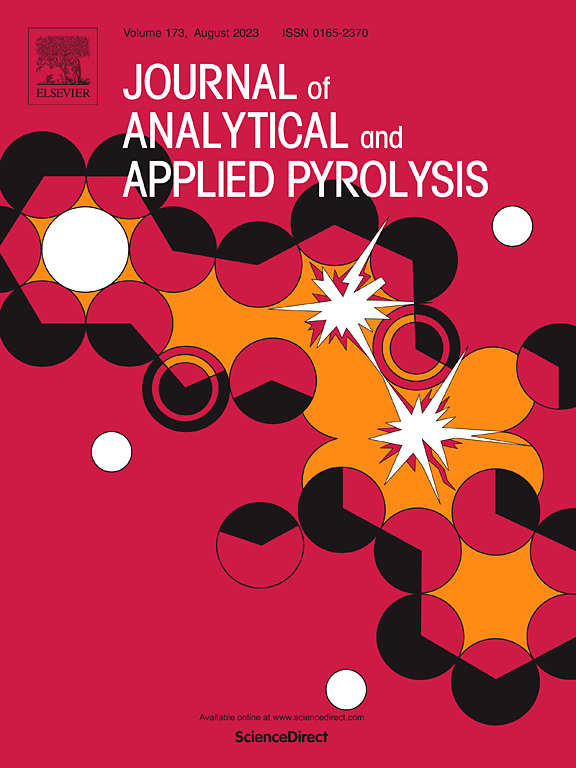Insight into pyrolysis degradation of polyester/cotton blended fabric with a system of two-component independent flame-retardation by Py-GC/MS analysis
IF 5.8
2区 化学
Q1 CHEMISTRY, ANALYTICAL
引用次数: 0
Abstract
Pyrolysis degradation of polyester/cotton (Terylene/cotton T/C) blended fabric is complex because the interaction of individual components generates more flammable volatiles and burns more intensely. Having previously reported a two-component independent flame-retardant (TIF) system of flame-retarding T/C blended fabric to inhibit the “scaffolding effect”, in which the polyester component was copolymerized of phosphorus containing flame retardant monomers and the cotton component was finished by grating vinyl ammonium phosphate (AMVP) (Xie et al. Polymer Degradation and Stability, 2024, 220, 110638). However, how these treatments influence the interaction between the cotton and polyester components during pyrolysis, the mechanisms behind flame retardancy remains unclear. Here a thorough study of the pyrolysis degradation of cotton, polyester, and T/C blended fabric with or without treatment using pyrolysis gas chromatography/mass spectrometry (Py-GC/MS) to identify the detailed pyrolysis products, allowing depicting the interactions of two components and the flame-retardant (FR) mechanism. The pyrolysis results of the TIF system show that the composition of pyrolysis products had changed compared to the commercial single FR finishing blended fabrics. The present of high benzoic acid/acetaldehyde ratio (2.85) demonstrated that the TIF system was inhibiting pyrolysis interference between the polyester and cotton components, in which independently charring and flame retardant, forming char barrier layers. Additionally, a high P-containing compounds (1.61 %) provided an explanation for the lower flammability. This work will shed light on the forthcoming research of FR mechanism for the new component independent FR blended fabrics.
双组分独立阻燃体系热解降解涤棉混纺织物的Py-GC/MS分析
涤纶/棉(涤棉/ T/C)混纺织物的热解降解比较复杂,因为各个组分的相互作用产生更多的可燃挥发物,燃烧更强烈。此前曾报道过一种抑制“脚手架效应”的双组分独立阻燃(TIF)体系,其中聚酯组分由含磷阻燃单体共聚,棉组分由磷酸乙烯铵(AMVP)光栅整理(Xie等)。高分子降解与稳定性研究,2004,22(1):6 - 6。然而,这些处理如何影响热解过程中棉和聚酯组分之间的相互作用,阻燃背后的机制尚不清楚。本文采用热解气相色谱/质谱法(Py-GC/MS)对棉、涤纶和涤棉混纺织物经过或未经处理后的热解降解进行了深入研究,以确定详细的热解产物,从而描绘了两种组分的相互作用和阻燃(FR)机理。TIF体系的热解结果表明,热解产物的组成与商业单一FR整理混纺织物相比发生了变化。较高的苯甲酸/乙醛比(2.85)表明,TIF体系抑制了聚酯和棉花组分之间的热解干扰,使其独立炭化和阻燃,形成炭阻隔层。此外,高含p化合物(1.61 %)解释了较低的可燃性。这项工作将为今后研究新型无组分FR混纺织物的FR机理提供指导。
本文章由计算机程序翻译,如有差异,请以英文原文为准。
求助全文
约1分钟内获得全文
求助全文
来源期刊
CiteScore
9.10
自引率
11.70%
发文量
340
审稿时长
44 days
期刊介绍:
The Journal of Analytical and Applied Pyrolysis (JAAP) is devoted to the publication of papers dealing with innovative applications of pyrolysis processes, the characterization of products related to pyrolysis reactions, and investigations of reaction mechanism. To be considered by JAAP, a manuscript should present significant progress in these topics. The novelty must be satisfactorily argued in the cover letter. A manuscript with a cover letter to the editor not addressing the novelty is likely to be rejected without review.

 求助内容:
求助内容: 应助结果提醒方式:
应助结果提醒方式:


